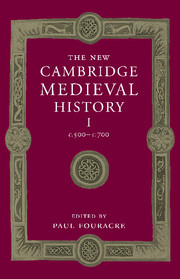Book contents
- Frontmatter
- Introduction: the history of Europe 500–700
- 1 The later Roman Empire
- 2 The Barbarian invasions
- 3 The sources and their interpretation
- PART I THE SIXTH CENTURY
- 4 The Eastern Empire in the sixth century
- 5 The Byzantines in the West in the sixth century
- 6 Ostrogothic Italy and the Lombard invasions
- 7 The formation of the Sueve and Visigothic kingdoms in Spain
- 8 Merovingian Gaul and the Frankish conquests
- 9 The Celtic kingdoms
- 10 The earliest Anglo-Saxon kingdoms
- PART II THE SEVENTH CENTURY
- PART III THEMES AND PROBLEMS
- List of Primary sources
- Bibliography of secondary works arranged by chapter
- Index
- Frontispiece"
- Plate section"
- Map 3 Gaul/Francia in the sixth and seventh centuries"
- References
10 - The earliest Anglo-Saxon kingdoms
from PART I - THE SIXTH CENTURY
Published online by Cambridge University Press: 28 March 2008
- Frontmatter
- Introduction: the history of Europe 500–700
- 1 The later Roman Empire
- 2 The Barbarian invasions
- 3 The sources and their interpretation
- PART I THE SIXTH CENTURY
- 4 The Eastern Empire in the sixth century
- 5 The Byzantines in the West in the sixth century
- 6 Ostrogothic Italy and the Lombard invasions
- 7 The formation of the Sueve and Visigothic kingdoms in Spain
- 8 Merovingian Gaul and the Frankish conquests
- 9 The Celtic kingdoms
- 10 The earliest Anglo-Saxon kingdoms
- PART II THE SEVENTH CENTURY
- PART III THEMES AND PROBLEMS
- List of Primary sources
- Bibliography of secondary works arranged by chapter
- Index
- Frontispiece"
- Plate section"
- Map 3 Gaul/Francia in the sixth and seventh centuries"
- References
Summary
introduction
By the time Bede began to write the Historia Ecclesiastica, the origins of the earliest Anglo-Saxon kingdoms were believed to lie in the ethnic pedigrees of Germanic invaders, primarily the three tribes named in the HE, the Angles, Saxons and Jutes, groups who gave their names to many of the earliest kingdoms. Indeed, the traditional view of kingdom formation takes as its point of departure the accounts of the invasions in the HE and the Anglo-Saxon Chronicle and sees the distribution of Anglo-Saxon cemeteries and settlements as marking out a process of military conquest and political takeover, in the course of which new kingdoms were carved out. An admirable example of this school of thought is Beck’s chapter on ‘The Teutonic conquest of Britain’, in the first volume of The Cambridge Medieval History published in 1911. Modern scholarship has at its disposal a range of data, especially in the form of archaeological remains, unimagined in Beck’s day, and the ‘conquest model’, a central tenet of English history, has crumbled since the 1970s as the origins of the Anglo-Saxon kingdoms have come under renewed scrutiny.
A new understanding, if not exactly a consensus, has emerged which is more complex, though less satisfyingly comprehensive, than Beck‘s vision. This view of England in the sixth century stems from an ongoing re-evaluation of four related issues: the scale and nature of Germanic immigration and, conversely, of British survival; the formation of ‘Anglo-Saxon’ social identities; the construction of power; and the formation of new economic structures as reflected in strategies of production and exchange.
Keywords
- Type
- Chapter
- Information
- The New Cambridge Medieval History , pp. 263 - 288Publisher: Cambridge University PressPrint publication year: 2005
References
- 3
- Cited by



